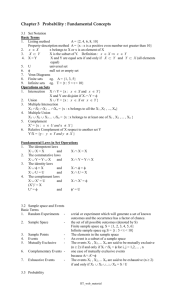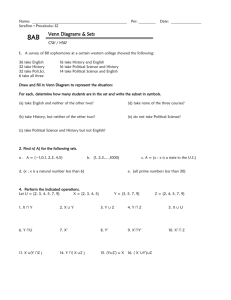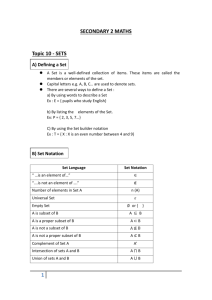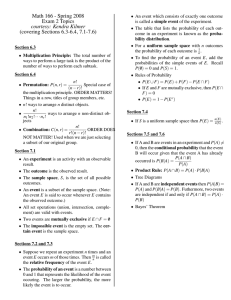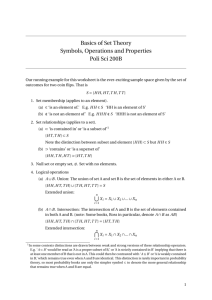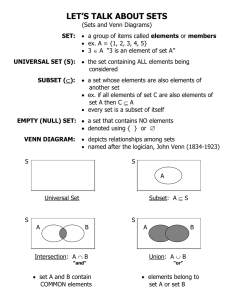Introduction to Set Theory James H. Steiger
advertisement
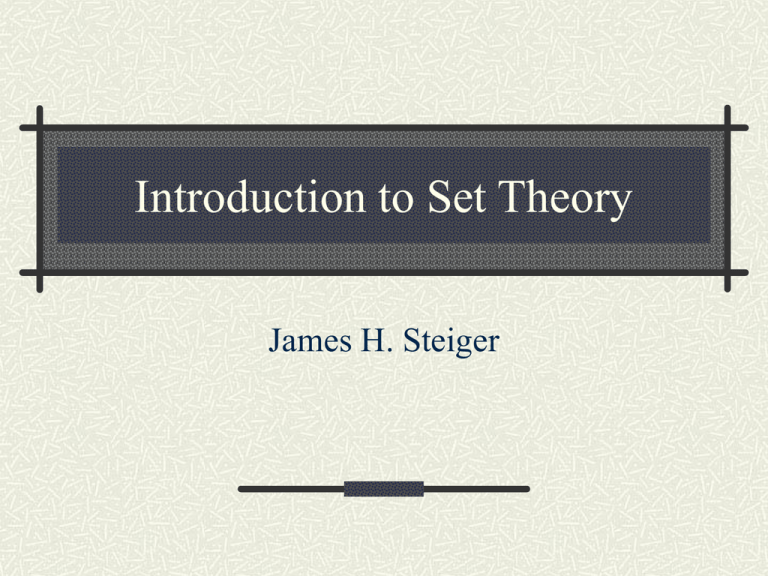
Introduction to Set Theory
James H. Steiger
Sets
Definition. A Set is any well defined collection of
“objects.”
Definition. The elements of a set are the objects in a
set.
Notation. Usually we denote sets with upper-case
letters, elements with lower-case letters. The
following notation is used to show set membership
x A means that x is a member of the set A
x A means that x is not a member of the set A.
Ways of Describing Sets
List the elements
A= 1,2,3,4,5,6
Give a verbal description
“A is the set of all integers from 1 to 6,
inclusive”
Give a mathematical inclusion rule
A=Integers x 1 x 6
Some Special Sets
The Null Set or Empty Set. This is a set with no
elements, often symbolized by
The Universal Set. This is the set of all elements
currently under consideration, and is often
symbolized by
Membership Relationships
Definition. Subset.
A B “A is a subset of B”
We say “A is a subset of B” if x A x B, i.e.,
all the members of A are also members of B. The
notation for subset is very similar to the notation
for “less than or equal to,” and means, in terms of
the sets, “included in or equal to.”
Membership Relationships
Definition. Proper Subset.
A B
“A is a proper subset of B”
We say “A is a proper subset of B” if all the
members of A are also members of B, but in
addition there exists at least one element c such
that c B but c A . The notation for subset is
very similar to the notation for “less than,” and
means, in terms of the sets, “included in but not
equal to.”
Combining Sets – Set Union
A B
“A union B” is the set of all elements that
are in A, or B, or both.
This is similar to the logical “or” operator.
Combining Sets – Set
Intersection
A B
“A intersect B” is the set of all elements that
are in both A and B.
This is similar to the logical “and”
Set Complement
A
“A complement,” or “not A” is the set of all
elements not in A.
The complement operator is similar to the
logical not, and is reflexive, that is,
A A
Set Difference
A B
The set difference “A minus B” is the set of
elements that are in A, with those that are in
B subtracted out. Another way of putting it
is, it is the set of elements that are in A, and
not in B, so A B A B
Examples
{1,2,3,4,5,6}
A {1,2,3}
B {3,4,5,6}
A B {3}
A B {1,2,3,4,5,6}
B A {4,5,6}
B {1,2}
Venn Diagrams
Venn Diagrams use topological areas to
stand for sets. I’ve done this one for you.
B
A
AB
Venn Diagrams
Try this one!
B
A
AB
Venn Diagrams
Here is another one
B
A
AB
Mutually Exclusive and
Exhaustive Sets
Definition. We say that a group of sets is
exhaustive of another set if their union is
equal to that set. For example, if A B C
we say that A and B are exhaustive with
respect to C.
Definition. We say that two sets A and B
are mutually exclusive if A B , that is,
the sets have no elements in common.
Set Partition
Definition. We say that a group of sets partitions
another set if they are mutually exclusive and
exhaustive with respect to that set. When we
“partition a set,” we break it down into mutually
exclusive and exhaustive regions, i.e., regions with
no overlap. The Venn diagram below should help
you get the picture. In this diagram, the set A (the
rectangle) is partitioned into sets W,X, and Y.
Set Partition
A
W
X
Y
Some Test Questions
A ?
Some Test Questions
A A=?
Some Test Questions
A ?
Some Test Questions
A A=?
Some Test Questions
AA ?
Some Test Questions
A ?
Some Test Questions
?
Some Test Questions
If A B then
AB ?
Some Test Questions
If A B then
AB ?
